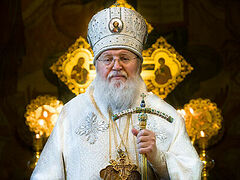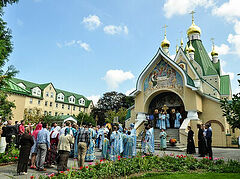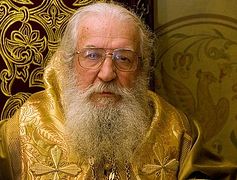 At the funeral of Metropolitan Anastassii. Holy Trinity Monastery, Jordanville, 1964
At the funeral of Metropolitan Anastassii. Holy Trinity Monastery, Jordanville, 1964
With wars, terror, and pressures on the Russian Orthodox Church under a government hostile to its very existence, the Church has nevertheless stayed its course. But different configurations have formed in the process. The history of the formation of the Russian Orthodox Church Outside of Russia and its reunification with the Moscow Patriarch is something that is by no means understood or studied by many Orthodox around the world. Deacon Andrei Psarev, historian and creator of the website, Rocor Studies, presented this historical paper in the year of reunification, 2007. It continues to be a valuable source of information on this subject.
The history of the Orthodox Church teaches us that ecclesiastical divisions tend to be most persistent when one of the estranged factions believes that the separation is predicated on doctrine. Without going many centuries back, it is sufficient to mention the controversy over the Russian Old Believers in the seventeenth century as well as the Greek Old Calendarist movement in the twentieth.
The divisions that result from what I would call political reasons are relatively easy to repair. By “political reasons” I refer to divisions caused by external events, such as a revolution or a change of a political regime. Even if in the course of years the separated factions try to attach putative doctrinal differences to the separation, the actual political causes of that separation make reunification much more feasible. The reunification of the homeland and diasporic branches of the Serbian Orthodox Church in 1992 is a distinctive example.
The reconciliation on May 17, 2007, of the Patriarchate of Moscow and the Russian Orthodox Church outside of Russia (ROCOR), also known as the Russian Church Abroad, has afforded us an opportunity to study the most recent model of successful reconciliation of two ecclesiastical bodies separated by political factors. In this paper1 we shall examine the ecclesiological attitude of the ROCOR toward the Patriarchate of Moscow in order to see what fundamentals allowed the development of a dialogue, what elements caused complications in rapprochement, and what elements could facilitate the future of a united Russian Church.
To elucidate the recent perception of the Moscow Patriarchate by the Russian Church Abroad, I will briefly sketch the historical antecedents of the ROCOR’s relations with the Moscow Patriarchate. I will also analyze the ROCOR’s conciliar pronouncements and other representative documents from the 1920s through the 1990s.
The ecclesiological trends of the Russian Church Abroad have reflected particular historical conditions. The ecclesiology of decentralization was largely a repercussion of the Soviet attempts to control the Orthodox Church. The same tendency of decentralization, although at a more problematic level, dominated the ecclesiology of the catacomb church. The Moscow Patriarchate’s strategy of maintaining its central administration by means of compromise with the government led to the ROCOR’s perception of the bishops of the Moscow Patriarchate as “enslaved.” Representatives of all church branches looked forward to an All-Russia Council, which, as a sequel to the council of 1917–18, was to be a spiritual landmark for the Soviet period of the Russian Church.
Branch in Exile and Church in Russia 1920–59
In 1919 the Southern Russian Church Council founded the Supreme Church Administration in the South of Russia (SCA-SR) in Stavropol. The president of the SCA-SR, Archbishop Dimitrii Abashidze of Tavrida, did not join the majority of the bishops under him when they evacuated from Сrimea to Istanbul as a result of the civil war. In Istanbul, the exiled administration was led by the senior refugee hierarch, Metropolitan Antonii Khrapovitskii of Kiev and Galicia.
Following their flight from Russia, the bishops continued to consider themselves under the jurisdiction of the church ad ministration based in Moscow. On November 19, 1920, the SCA-SR met aboard a ship in Istanbul Harbor. Discussions there centered on what the SCA-SR could do by way of ministering to Russian exiles given the impossibility of maintaining relations with the Supreme Church Administration in Russia (SCA-R). Thus, the Supreme Church Administration Abroad was established (SCA-A).
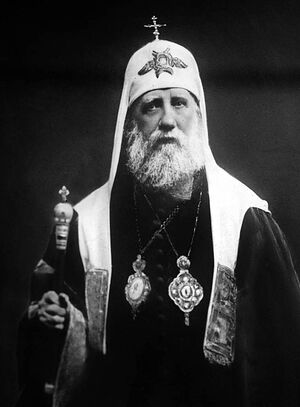 Patriarch Tikhon of Moscow Despite the fact that the SCA-A was established outside the bounds of the canonical territory of Patriarch Tikhon, he nonetheless blessed its activities in the Patriarchate of Constantinople.2 At the same time, the Russian bishops abroad considered themselves in subordination to the SCA-R. One of the documents published by the First Pan Diaspora Council (1921) stated that the council recognized that it was under the authority of the Patriarch of Moscow.3 Likewise, all the decrees issued by the SCA-A began with the standard phrase, “By the blessing of His Holiness, the Patriarch of Moscow and all Russia.” Thus the members of the Russian Church Abroad did not conceive of their ecclesiastical body as being independent from Patriarch Tikhon and the ecclesiastical administration in Russia. However, the subsequent disparate realities of life in the diaspora and life in the homeland led to widely different ecclesiastical policies. On May 5, 1922, under pressure from the OGPU sixth division4 (Soviet secret police in charge of arresting and incarcerating Russian Orthodox clergy), Patriarch Tikhon, along with the holy synod and the Supreme Church Council, issued a decree dissolving the SCA-A.
Patriarch Tikhon of Moscow Despite the fact that the SCA-A was established outside the bounds of the canonical territory of Patriarch Tikhon, he nonetheless blessed its activities in the Patriarchate of Constantinople.2 At the same time, the Russian bishops abroad considered themselves in subordination to the SCA-R. One of the documents published by the First Pan Diaspora Council (1921) stated that the council recognized that it was under the authority of the Patriarch of Moscow.3 Likewise, all the decrees issued by the SCA-A began with the standard phrase, “By the blessing of His Holiness, the Patriarch of Moscow and all Russia.” Thus the members of the Russian Church Abroad did not conceive of their ecclesiastical body as being independent from Patriarch Tikhon and the ecclesiastical administration in Russia. However, the subsequent disparate realities of life in the diaspora and life in the homeland led to widely different ecclesiastical policies. On May 5, 1922, under pressure from the OGPU sixth division4 (Soviet secret police in charge of arresting and incarcerating Russian Orthodox clergy), Patriarch Tikhon, along with the holy synod and the Supreme Church Council, issued a decree dissolving the SCA-A.
In an attempt to release Patriarch Tikhon from responsibility for emigre clergy, the ROCOR bishops council on September 2, 1922, dissolved the SCA-A. The same council established the Synod of Bishops of the Russian Church Abroad, the current ecclesiastical authority, based on the Ukase No. 362 promulgated by Patriarch Tikhon, the holy synod, and the Supreme Church Council (Oct. 20, 1920).5 This decree allowed for the decentralization of church administration in the Russian Church in the event of political upheaval.
On June 30, 1923, Patriarch Tikhon was released from prison. In various pronouncements that appeared in Soviet periodicals, he went so far as to reprimand the anti-Soviet political activity of the Russian Church Abroad. On November 12, 1925, eight months after the death of Patriarch Tikhon, the Synod of Bishops of the ROCOR recognized Metropolitan Peter Polanski of Krutitsy as the Locum Tenens of the patriarchal throne.
Throughout all the years of Patriarch Tikhon’s reign, the patriarchal church had been unable to obtain legitimate, corporate status within the framework of the Soviet system. The Soviet government granted corporate privileges only to the “innovationist” church. Without corporate status, all dioceses and parishes of the Tikhonite church had quasi-legal standing in the USSR and were forbidden to maintain foreign relations. Like the ancient Christian apologists, Patriarch Tikhon and his successor, Metropolitan Peter, tried to promote their quest for corporate rights by stating in their pronouncements that Orthodox Christians were loyal citizens of the “Soviet empire.”
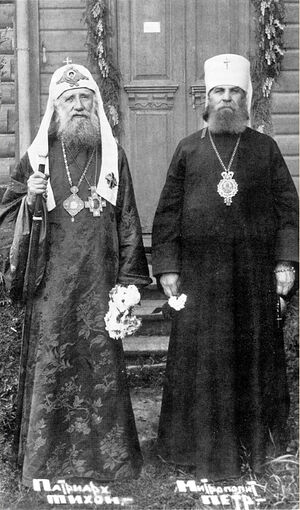 Patriarch Tikhon of Moscow and Metropolitan Peter of Krutitsy Metropolitan Peter, whom Patriarch Tikhon had deputized, in turn appointed a number of clerics to serve as his own deputies.6 Only one of them, Sergii Staragorodskii, Metropolitan of Nizhnii-Novgorod from December 1925 to 1936, actually served as Metropolitan Peter’s deputy. Until his arrest in November 1926, Metropolitan Sergii ruled by consensus with the other bishops. In March 1927, he was unexpectedly released from prison. In May, Metropolitan Sergii organized a synod of hand-chosen hierarchs, over which he presided.
Patriarch Tikhon of Moscow and Metropolitan Peter of Krutitsy Metropolitan Peter, whom Patriarch Tikhon had deputized, in turn appointed a number of clerics to serve as his own deputies.6 Only one of them, Sergii Staragorodskii, Metropolitan of Nizhnii-Novgorod from December 1925 to 1936, actually served as Metropolitan Peter’s deputy. Until his arrest in November 1926, Metropolitan Sergii ruled by consensus with the other bishops. In March 1927, he was unexpectedly released from prison. In May, Metropolitan Sergii organized a synod of hand-chosen hierarchs, over which he presided.
According to the All-Russia Council of 1917–18, the Synod of Bishops of the Russian Church was to be elected by the local council. The executive authority of Metropolitan Sergii’s synod, however, derived from his position as a sub-statute to the Locum Tenens. His synod was not simply an unofficial advisory board but an executive body registered by the state. For this project, he did not ask the blessing of Metropolitan Peter, the Locum Tenens. In fact, Metropolitan Sergii was merely a substitute for the Locum Tenens, and in this position, it was at least questionable whether he could undertake, on his own, projects that would have a substantial impact on the Church.
Like his predecessors, Sergii tried to lead the Russian Orthodox Church out of its legal deadlock, and on July 29, 1927, he issued his apologia (commonly known as the “Declaration”), a statement of loyalty to the Soviet government, in which he interprets the negative attitude of the Soviet government toward the Russian faithful as a direct result of the activity of Russian ecclesiastical emigres. Metropolitan Sergii demanded from the clergy abroad a pledge of loyalty to the Soviet government. Inside the country, he excluded imprisoned clergy and laity from liturgical commemoration, but authorized commemoration of the Soviet government. He did so in marked contrast to Patriarch Tikhon, who, though invested with patriarchal authority and elected by the All-Russia Council, was sensitive to the diversity of views within his church. For example, Tikhon revoked his decrees adopting the Gregorian calendar and receiving Archpriest Krasnitskii into communion, which had not met with the support of the Orthodox pleroma.
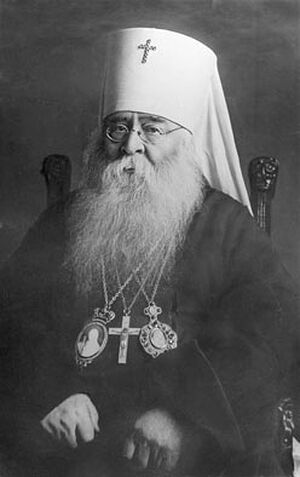 Metropolitan Sergii (Stragorodsky) Metropolitan Sergii began to issue canonical sanctions against those bishops who, because of their unwillingness to accept this new course, separated themselves from him. Many Russian bishops considered Sergii’s stance an act of usurpation. At that time, the Russian Orthodox Church had about 150 bishops inside Russia. According to conservative estimates, no less than forty of them had failed to support Metropolitan Sergii in one way or another. By 1937, five metropolitans had been deposed by Metropolitan Sergii and his synod7, a situation without precedent in the history of the Russian Church. Reacting to this situation, the Bishops Council of the Church Abroad on September 5, 1927, resolved:
Metropolitan Sergii (Stragorodsky) Metropolitan Sergii began to issue canonical sanctions against those bishops who, because of their unwillingness to accept this new course, separated themselves from him. Many Russian bishops considered Sergii’s stance an act of usurpation. At that time, the Russian Orthodox Church had about 150 bishops inside Russia. According to conservative estimates, no less than forty of them had failed to support Metropolitan Sergii in one way or another. By 1937, five metropolitans had been deposed by Metropolitan Sergii and his synod7, a situation without precedent in the history of the Russian Church. Reacting to this situation, the Bishops Council of the Church Abroad on September 5, 1927, resolved:
-
The branch of the All-Russian Church located outside of Russia must cease administrative relations with the Moscow Church authority because of its enslavement to the godless Soviet power, which has deprived it of the freedom to express and to guide the Church according to the canons;
-
In order to release our hierarchy from responsibility for the part of the Russian Church located abroad that had not recognized the authority of the Soviet power, until normal relations with Russia are restored and until the liberation of our Church from the persecution of the godless Soviet power, the branch of our Church located abroad should govern itself in accordance with the Holy Canons, Resolutions of the Sacred Local Council of All Russian Orthodox Church of 1917–18 and by the decree of His Holiness Patriarch Tikhon, Holy Synod and Supreme Council from 7/20 of November 1920; by the assistance of the Bishops Synod and the Council of Bishops with the Kievan Metropolitan Antonii presiding;
-
The branch of the Russian Church abroad considers itself an indissoluble spiritually united branch of the Great Russian Church. It has not separated itself from the Mother Church and does not consider itself autocephalous. It still regards the Patriarchal Locum Tenens Metropolitan Peter as head of the church and commemorates his name during the services;
-
If there should be a resolution of Metropolitan Sergii and his Synod concerning the excommunication of bishops and clergy abroad who are not willing to sign a pledge of loyalty to the Soviet Government, such a resolution will be uncanonical.8
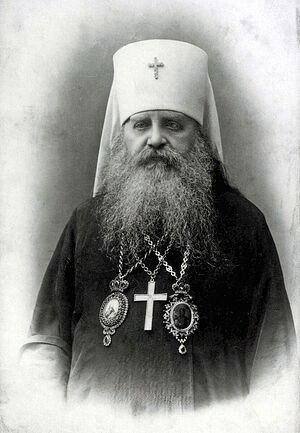 Metropolitan Antonii (Khrapovitsky) This epistle was signed by Metropolitan Antonii and eleven Russian bishops abroad.
Metropolitan Antonii (Khrapovitsky) This epistle was signed by Metropolitan Antonii and eleven Russian bishops abroad.
On June 21, 1928, Metropolitan Sergii announced that he was abolishing the Supreme Church Administration of the Russian Church Abroad and that, should the ROCOR’s bish ops not repent, they would be subject to prosecution by the ecclesiastical court and suspension from church functions. The synod of bishops reasonably inferred that Metropolitan Sergii’s pronouncements were coerced by the OGPU, which desired to halt Russian emigration.9 Six years later, in his statement of June 22, 1934, Metropolitan Sergii suspended the ROCOR bishops from service. In accordance with the 1923 resolution of the synod of bishops10 not to fulfill decrees of the Higher Church Authority in Russia that had been influenced by Soviet pressure, the Council of Bishops of the Russian Church Abroad rejected the suspension as illegitimate.
On September 26, 1937, Metropolitan Peter, Locum Tenens of the patriarchal throne, was martyred. The question arose as to whom the Russian Church Abroad should commemorate as legitimate head of the hierarchy in Russia. In December 1937, the Council of Bishops of the Russian Church Abroad recommended that Metropolitan Kirill Smimov of Kazan’, the first Locum Tenens of Patriarch Tikhon, be recognized as First Hierarch: “In order to clear Metropolitan Kirill of responsibility for the actions of the Russian emigre bishops, the Council decided that his name would be commemorated secretly, but that at various occasions during the divine ser vices, ‘the Orthodox Episcopate of the Church of Russia’ would be commemorated.”11
The rite of reception of clergy provides an important in sight into the ecclesiastical status of the church body to which the clergy being received formerly belonged. On August 16, 1938, the bishops council decided that clergy arriving from Russia who had served under Metropolitan Sergii could be accepted into communion without any rite of reception, since they were not responsible for his eccle siastical transgressions.12 On May 10, 1944, the ROCOR synod of bishops determined that the only canonical church in Ukraine was the Ukrainian Autonomous Church of the Moscow Patriarchate.13 When all bishops of the Byelorussian Autonomous Church (also formed under the auspices of the Moscow Patriarchate) fled their country near the end of World War II, they were received into the Russian Church Abroad without any rite of reception.
The situation changed with the November 9, 1959, decision of the bishops council that petitions from patriarchate clergy who wanted to join the Russian Church Abroad should be carefully reviewed to determine if the clergy were Soviet agents. If so, the synod of bishops should refuse to recognize the validity of their ordination. In other cases, clergy could be received according to the practice of reception of the Russian renovationists. Diocesan bishops were also given the right to impose a penance on such clergy. Clergy entering the Russian Church Abroad were to write, “I sincerely regret my presence among the clergy of the Moscow Patriarchate, which is in union with the godless power. I renounce all illegal acts of the Moscow hierarchy in connection with the godless power.”14 In receiving laymen as well, the confessors were to examine their actions under the godless power.15 The reception by the Russian Church Abroad of clergy from the Patriarchate of Moscow through repentance was a response to the Patriarchate of Moscow, which that same year (1959) had received through repentance the Church Abroad’s Archbishop Panteleimon Rudik.
Review Of the Ecclesiology
-
The Ukase No. 362
On November 20, 1920, Patriarch Tikhon, along with the holy synod and the Supreme Church Council, issued Ukase (Decree) No. 362,16 which introduced the principle of decentralization into the Russian Church. The essential point of this decree is that if in extraordinary circumstances a diocese of the Russian Church should find it impossible to maintain contact with the central authority of the Russian Church, or if the central authority itself should cease to exist, the diocese should administer itself. The diocesan bishops are obliged to establish communications with other bishops in similar circumstances. All decisions made by an independent diocese should be submitted for approval to the central authority of the Russian Church as soon as this should prove possible.
In reality the administration of the Russian Church Abroad had been functioning effectively on this principle prior to emigration, when the Supreme Church Administration was established in the southeastern region of Russia, which was controlled by the White Army. The Russian Church Abroad considered that this ukase officially authorized self-governance while facilitating affiliation with the Russian Church without submission to the Bolshevik-controlled central administration. The first paragraph of the “Regulations of the Russian Orthodox Church outside of Russia”17 reads, “The Russian Orthodox Church Abroad is an indissoluble part of the Russian Orthodox Church, and for the time, until the extermination in Russia of the atheist government, is self-governing on conciliar principles in accordance with the resolution of the Patriarch, the Most Holy Synod, and the Highest Church Council of the Russian Church, dated 7/20 November, No. 362.”18
The ROCOR council of 1943 did not recognize the validity of the election of Metropolitan Sergii as patriarch, since only bishops of his own faction had participated in the so-called open elections. This made it difficult to recognize the authority of the Patriarchate of Moscow as successor to the SCA-R that issued Ukase No. 362. In any case, this “technical,” canonical aspect of the controversy had little importance to the majority of Russian emigrants, since, for political, practical, and psychological reasons, they could not accept subordination to the “Soviet Church.”
The fact that the ROCOR followed this ukase in good faith is seen from their willingness to enter into a dialogue with the Church of Russia, even if this could have been done right after the collapse of the USSR. In November 2001, an inter national conference on the modem history of the Russian Church took place in Hungary. Scholars from the Moscow Patriarchate and the Russian Church Abroad concurred in resolving that “the Church-Law heritage of the undivided Russian Church (specifically Ukase No. 362 from 7/20 November 1920) returns us to our common roots of the perception of catholicity in the Orthodox Church of Russia. These processes allow us to believe that conciliar efforts will overcome this separation of many years.”19
-
The Underground Branch of the Russian Church
In 1970, the Orthodox Church in America received autocephaly from the Russian Orthodox Church. The result was a special resolution on the catacomb church by the ROCOR’s bishops council, proclaimed on September 14, 1972, according to which the ROCOR was in communion with the cata comb church, but not with the Moscow Patriarchate: “The free part of the Russian Church, which finds itself outside the boundaries of the USSR, is heart and soul with the confessors of the faith, whom the anti-religious manuals call ‘True Orthodox Christians,’ and who in common usage are often called ‘the Catacomb Church’; for they are obliged to hide themselves from the civil authorities in the same way that believers hid in the catacombs in the first centuries of Christianity.”20
The Russian Church Abroad saw the catacomb church consisting of those hierarchs, clergy, and faithful who refused to commemorate Metropolitan Sergii as its ecclesiastical counterpart in Russia. Most of the bishops who had broken communion with Metropolitan Sergii, including Metropolitan Kirill of Kazan’, had been executed ‘in Stalin’s purges of the 1930s.
By the 1950s very few bishops in Russia had failed to join the Moscow Patriarchate.21 Since those bishops had not ordained any other bishops, the catacomb church evolved into a system of communities isolated from each other, often without priests. In his letter to the Third Pan-Diaspora Council (1974), Alexander Solzhenitsyn warned the ROCOR against the delusion that the catacomb church was a network covering all of Russia.22
The absence of canonical bishops in the catacombs turned the attention of some Christians toward the Russian Church Abroad. In the 1960s, Rassaphor-Monk Theodosii (Feodor Zhurbenko) was seeking ordination as presbyter by a bishop free from Soviet control. The ROCOR’s Archbishop Leontii Filipovich of Chile and Peru advised him to approach Archbishop Veniamin Novitskii of Irkutsk and Chita, who, although nominally within the Moscow Patriarchate, was actually acting independently of Soviet control. In 1977, the ROCOR received under its omophorion fourteen persons who had been clergy of the late catacomb bishop Antonii Galynskii-Mikhailovskii.23 In 1982, by resolution of the Council of the Russian Church Abroad, Theodosii (in small schema Lazar) was secretly ordained for the catacomb church by a ROCOR bishop who traveled incognito to Moscow.24 A letter dated March 11, 1982, from Bishop Gregorii Grabbe of Manhattan, then the secretary of the synod, to Archbishop Antonii Barthoshevich of Geneva and Western Europe, justified not sending candidates to bishops of the Moscow Patriarchate: “Seeking ordinations even from the best bishops of the Patriarchate is impossible. This would undermine the understanding of the difference between the Patriachate and the Catacombs so much that it might defeat the whole affair. Service [in the church] there is so dangerous that the most devout members would not take it upon themselves if not for the necessity of the conditions ... We can receive priests of the Patriarchate in their present rank, just as we have done before, but for the sake of those in the Catacombs themselves we cannot send candidates for ordination even to their [the Moscow Patriarchate’s] very best bishops.”25
The bishops of the ROCOR readily admitted that they were out of contact with the complicated realities of church life in the USSR.26 This proved to be true. After the fall of the Iron Curtain, it turned out that the entire catacomb church had no more than a few hundred members. The only hierarchy of the catacomb church in Russia that traced its origin from Serafim Pozdeev appeared to be illegitimate, since its found er was in fact not a bishop but an imposer.27 The only canonical bishop of the catacomb church in Russia was Lazar Zhurbenko (mentioned above), who had been ordained by the ROCOR.
The identification of the catacomb church by the Russian Church Abroad as the genuine Russian Church created a dilemma that played a crucial role for the members of the ROCOR in the recent debate over union with the Moscow Patriarchate. If the catacomb church is the authentic Russian Church, what is the sacramental standing of the official church, that is, the Moscow Patriarchate? The following passage in a letter from Archbishop Antonii of Geneva to Fr. Dimitrii Dudko (May 1979) demonstrates that regardless of radical statements by individuals (including bishops), the ROCOR had never proclaimed ex cathedra that the Patriarchate of Moscow was devoid of sacramental grace: “[T]he free part of the Russian Church that exists abroad has never considered the Patriarchate of Moscow, officially recognized in the USSR, void of grace ... In recent times we have been guided in our relationship with the Patriarchate by the opinion of the universally respected and venerated Archbishop John [of Shanghai], who said that of course the mysteries of the official Church in the USSR were valid; however, he maintained that the behavior of its leaders was unacceptable. We should try to avoid those bishops and their co-celebrants abroad. At the same time we are accused by the Catacomb Church in Russia of not rejecting the sacraments of the Patriarchate of Moscow as void of grace.”28
Another crucial question remained to be answered prior to the union with the Moscow Patriarchate: What ecclesiastical authority was to be assumed in the liturgical commemoration of the Russian Church Abroad as “the Orthodox Episcopate of the Church of Russia”? Historical evidence demonstrated that the branches canonically connected with the Church of Russia are the ROCOR and the Moscow Patriarchate. However, the hierarchy of the Russian Church Abroad could not consider the Patriarchate of Moscow either under Sergii or after him to be the true mother church; nor could the ROCOR consider the catacomb church to be the mother church, as it consisted only of unconnected networks of faithful and clergy without hierarchy. And the hierarchy of the Russian Church Abroad could hardly apply this commemoration to themselves.29
-
The Enslaved Branch of the Russian Church
Apart from the fact that the parishioners of the Moscow Patriarchate from Russia were allowed to receive Holy Communion in churches of the Russian Church Abroad and the ROCOR in Russian churches, the following excerpt from the epistle of the 1988 bishops council demonstrates that the ROCOR had a more nuanced understanding of the church situation in the USSR than the simplified dichotomy (true church versus false church) may suggest: “Today the Church of Russia is, first of all, the vast sea of believers of our land, who are harassed and persecuted for the sake of Christ and His truth, pastors [of the Moscow Patriarchate] who have withdrawn into the catacombs of their hearts, fathers and mothers who save their children from atheism and unbelief by their prayers ... all of them strong in their weakness, of whom today’s world is not worthy.”30
However, these pious clergy and laity of the Russian Church were in full ecclesiastical communion with their “Sergianist” bishops. In 1990, attempting to reconcile this reality with the ROCOR’s attitude, the Council of Bishops of the Russian Church Abroad published an epistle espousing a theory of “autonomous” sacramental grace consistent with Donatist ecclesiology: “We believe and confess that in those churches of the Patriarchate of Moscow where the priest fervently believes and sincerely prays, showing himself to be not only a ‘minister of the cult,’ but also a good shepherd who loves his sheep, to those who approach him with faith, the grace of salvation is accessible in the mysteries.”31 Because of the incompatibility of this approach with the teaching of the Orthodox Church that the availability of grace for a celebrant does not depend on his righteousness, the council of bishops decided in 1991 that the above paragraph should be removed from the epistle. However, the following passage in the same epistle, which some might claim is ambiguous, was left intact: “Priests and believers from Russia are appealing to us to cover them with our omophorion, to impart grace to them.”32 The statute adopted by the council of bishops in 1990 concerning the Free Russian Orthodox Church—the name given to Russian Church Abroad communities in Russia offers a number of justifications for the reception of communities in the USSR into the Russian Church Abroad: the participation of the Moscow Patriarchate in the World Council of Churches, moral issues such as arrogant behavior of the hierarchy, and the uncanonical transfer of bishops and clergy. Such mention of moral issues as the reason for the reception of faithful is the only other similarity with the Donatist approach in the ecclesiology of the ROCOR that I have come across in my research.
The conflicts within the ROCOR dioceses in Russia and the confrontation with the Moscow Patriarchate motivated the 1994 bishops council to undertake a dialogue with the Russian Orthodox Church: “Conscious of our own responsibility before God and men, we, the hierarchs of the Church of Russia who are free of all outside interference, propose that the time has come to seek an active contact with all the parts of the One Russian Orthodox Church, which have been separated from one another on the strength of historical circumstances.”33 The council of the ROCOR bishops that took place in October 2000 turned the attention of the faithful toward unfolding positive developments within the Moscow Patriarchate-for example, the glorification of the New Martyrs of Russia and the acceptance of The Foundations of the Social Concept, which clearly defines the limits of church-state cooperation.
Undoubtedly, the ROCOR conciliar epistle of 2000 was based on the ecclesiology of the estranged branches of the Russian Church, not acceptable to those who share what I would call the “neo-catacomb ecclesiology.” In this system, the Patriarchate of Moscow is “a schismatic and heretical sect that separated from the Russian Orthodox Church in 1927 under Metropolitan Sergius and continues to remain until now in that evil schism.”34 No communication with such an unrepentant entity could lead to any good. Since the catacomb church has virtually died out, the only successor to the historical Russian Church is the Russian Orthodox Church Abroad. This conflict of ecclesiological trends explains to a considerable extent the tensions within the ROCOR, which arose with new force following the council of October 2000 and persisted until the unification in 2007.
-
An All-Russia Council as Facilitator of Unity
From the very beginning of its existence, the ROCOR had to protect the rights of Russian bishops in the homeland. When Patriarch Tikhon was arrested in 1922 with no indica tion that he would ever be released, several ROCOR bishops proposed that the ROCOR synod temporarily assume the functions of supreme ecclesiastical authority of the Russian Church. Responding to this proposal, the 1923 ROCOR Bishops Council decided that it was obliged to represent the free Russian Church in exile, but that none of the refugee bishops had the rights “that belong in their fullness only to the Russian Church on behalf of its legitimate hierarchs.”35
At the same time, the Russian emigre bishops had to be vigilant of their own rights as members of the episcopate of the Russian Church. In June 1934, Metropolitan Sergii and his synod suspended the leading bishops of the ROCOR. In his response to this decree, Metropolitan Antonii pointed out that the ROCOR was established as a provisional metropolia on the basis of Ukase No. 362, which could be canceled only by the legitimate organ of the supreme ecclesiastical authority; at that time, there was no such authority in Russia. Until the restoration of the normal order, Antonii considered himself accountable to the ROCOR Bishops Council established pursuant to Ukase No. 362; the decisions of that council could be revoked only by the All-Russia Church Council. He points out that the thirty-fourth apostolic canon reveals an important rationale for the conciliar phronema: If Metropolitan Sergii had never solicited advice from the Russian bishops in the diaspora when he was initiating his dubious synod at home, why was he suspending the emigre episcopate on the basis of their disloyalty to the Soviet gov ernment?36
The German invasion of Russia in 1941 provided a chance for Russian expatriates to return to their fatherland. Faced with the impending capture of Moscow, the ROCOR synod wrote to the German authorities in June 1942 that “according to the canons of the Orthodox Church there is only one approach for establishing church administration [in Russia]. That is the convocation of the council of the Russian Church by the eldest bishop, and the assignment by this council of an interim first hierarch and the organs of church administration.”37 The synod considered Metropolitan Kirill, who they mistakenly believed was “still in exile,”38 to be the first hierarch of the Russian Church. In any event, according to this document, the spiritual and canonical successor to Patriarch Tikhon should be chosen from among the bishops who shared the values of Metropolitan Kirill. On the practical level, the ROCOR had tried during World War II to support the dioceses of the Russian Church in occupied territories; for instance, it ordained a bishop for the Byelorussian Church in 1943.
Since World War II, the idea of the Second All-Russia Council continued to occur in official ROCOR documents: ‘“The Spiritual renewal of Russia and liberation of the Church has yet to come’; and then the Patriarchate of Moscow and the Catacomb Church and we, the Church Abroad, will stand trial before the local Council of the Russian Orthodox Church” (“The Epistle of the Third Pan-Diaspora Council in 1974 to the Faithful in Russia”).39 The Resolution of the Fourth Pan-Diaspora Council in 2006 reads, “We hope that the forthcoming Local Council of the One Russian Church will settle remaining unresolved church problems.”40
The bishops of the Russian Church Abroad regarded themselves as a branch of the Russian Church, spiritually unit ed with those bishops who were martyred in Russia; both groups intended to convene an All-Russia Church Council as a sequel to the 1917–18 council. The All–Russia Church Councils of the Moscow Patriarchate (1945–90) were not recognized by the ROCOR, since there were no free elections. However, the practical side of such a prospective council has never been discussed. After the adoption of the Statute of the Russian Orthodox Church at the 2000 Bishops Council of the Moscow Patriarchate, the local council became an irregular event convened at the discretion of the bishops’ council. Since many decisions of the 1917–18 local council have been ignored by the Patriarchate of Moscow and the ROCOR, it makes little sense to regard the legacy of this council as a point of common reference. It is not clear how to work out an agenda for such a council or how the procedures of the council should be conducted, especially when one considers the disproportionately large number of bishops and delegates from Russia and the small number of their counterparts from the diaspora.
Conclusion and Contemporary Implications
The condition of the Russian Church in the militant atheistic state was unprecedented. The documents of the OGPU crucial for an understanding of the relations between Metropolitan Sergii and Soviet officials are still sealed. At present it is safe to speculate that Metropolitan Sergii could legitimately have continued with his synod if he had not presumed to consider himself the rightful executor of central church authority, but simply a unit of the church as prescribed by Ukase No. 362. The canonical status of refugee bishops was also irregular, and they, like Metropolitan Sergii, considered themselves to be the only central authority in their own realm abroad. Ironically, again like Metropolitan Sergii, they resorted to imposing canonical sanctions on colleagues who disagreed with them.
The canons do not provide a guide for the perplexed in time of persecution, and hence the ecclesiology of the Russian Church Abroad in this period resulted not from canon law but from the intuition of its bishops. In general, the ROCOR succeeded in overcoming the temptation to proclaim itself the supreme authority of the Russian Church. The most notable exception to this moderate approach was the reception of parishes in Russia. This venture came as the result of various factors, including triumphalism, naivete, and—last but not least—the ecclesiology of the catacomb church. The reception of parishes in Russia catalyzed the internal crisis in the ROCOR that subsequently resulted in a dialogue between the ROCOR and the Moscow Patriarchate. The ecclesiology of Ukase No. 362 became an important instrument in this dialogue. It is quite understandable that a number of ROCOR clergy and parishioners both in Russia and in the diaspora, who regarded the anti-Sergianist stance as an authentic tradition of the ROCOR, were unable to evolve so adroitly as the leaders of the ROCOR, and ended up abandoning ship.
It is noteworthy that despite the ROCOR’s negative stance toward the ecumenical movement, the union of the ROCOR and the Moscow Patriarchate became a rare example of true ecumenical dialogue that has helped the two estranged branches understand each other’s historical and ecclesiological backgrounds in order to delineate a common ontological ground. On one hand, the exiled unit has accepted the truth that, canonical compromises notwithstanding, the only mother church would have to be the formerly enslaved component of the Russian Church. On the other hand, it is now the consensus of the Moscow Patriarchate that the independent mission of the Russian Church Abroad during the communist period was justified.
My research leads me to the following conclusion. Although decentralization could be useful during extraordinary circumstances (Ukase No. 362), the canonization of that approach could lead to isolationism and self-sufficiency (Religious Underground). At the same time, the ideal of an All-Russia Local Council as a facilitator of unity is still vital to the Russian Orthodox Church. It is doubtful that we can expect the emergence of an All-Russia Council with the catholic (universal) stance suitable for a sequel to the 1917–18 council. However, the ROCOR’s survival without state patronage as well as the close ties between its bishops and dioceses may enhance freedom of expression within the Russian Church by pitting the power of sobornost against any authoritarian tendencies.
The words of Hieromartyr Kirill the Metropolitan of Kazan’, a fascinating church leader and teacher of the twentieth century, are a reminder that a pneumatological perspective is an integral part of Orthodox ecclesiology: “[C]hurch discipline is capable of preserving its efficacy only as long as it is an actual reflection of the hierarchical conscience of the Catholic Church; and discipline can never itself replace this conscience. As soon as it produces its demands not by force of the indications of this conscience, but by impulses foreign to the Church and insincere, the individual hierarchal conscience unfailingly will stand on the side of the Catholic hierarchical principle of the Church’s existence, which is not at all one and the same thing as outward unity at any cost.”41 The question now is whether the Russian Church Abroad will choose this path of hierarchical conscience over the path of military-style discipline.
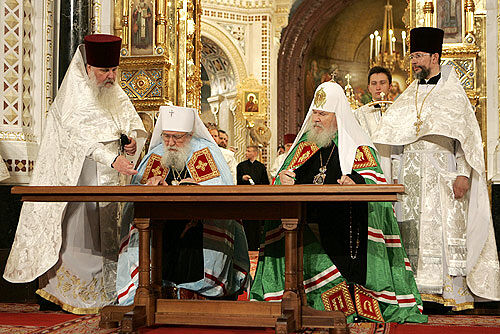 Metropolitan Laurus and patriarch Alexy II sign the Act of Canonical Communion between the Moscow Patriarchate and the Russian Orthodox Church Outside Russia. Photo: wikipedia
Metropolitan Laurus and patriarch Alexy II sign the Act of Canonical Communion between the Moscow Patriarchate and the Russian Orthodox Church Outside Russia. Photo: wikipedia

